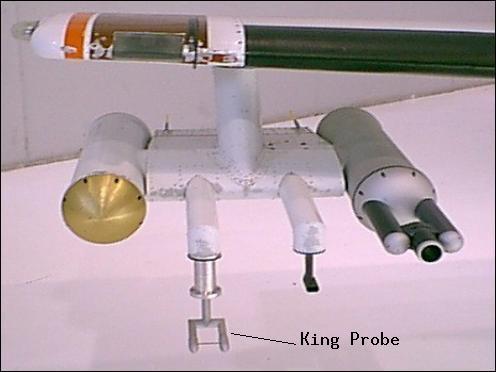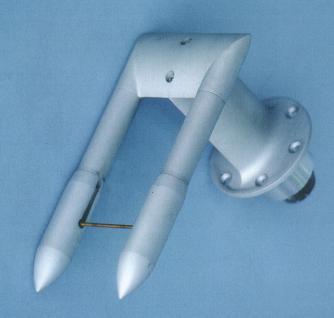
The University of North Dakota's citation aircraft can measure a cloud property known as liquid water content (LWC). It is defined as the mass of liquid water in a given volume of air. It is measured by an instrument called a King probe.

The probe is manufactured by Particle Measuring Systems, Inc. in Boulder Colorado. It consists of a long, thin metal coil 4. 0 cm in length, 2.0 cm of it is the master coil exposed to the air, and .187 cm in diameter. The coil is connected to a circuit and a voltage is supplied to the coil at a constant temperature of about 185 degrees Celcius. When water droplets come in contact with the coil they evaporate due to the high temperature of the coil. The latent heat is to evaporate the water is supplied by the coil. The coil is controlled to maintain a constant temperature throughout this process by an electric circuit. This voltage can be measured and is proportional to the energy provided to the water droplets. This energy quantity tells how much liquid water is in cloud.
The power supplied to keep the coil at a constant temperature is made up of the sum of two components. Not only is power supplied due to the evaporation of water but it is also supplied because energy is transferred to the surrounding air molecules because of the difference in temperature between the air and the coil. The liquid water content is calculated by using measured values of the voltage, air speed, ambient air temperature, and pressure in an equation and solving for the LWC. This equation is shown on the equations page.
The King probe can accurately measure droplets in the range between 10 and 40 micrometers in diameter, according to "The Drop-Size Response of the CSIRO Liquid Water Probe" by Biter, Dye, Huffman, and King. There is an average error of about five percent for droplets smaller than 10 micrometers because the smallest droplets tend to follow the streamlines of air around the coil. For droplets of diameter greater than 40 micrometers the error gradually increases to about 50% for droplets of about 150 micrometers in diameter.
The data collected by the King probe is used in projects to study cloud properties, such as aircraft icing. Most recently data from the King probe has been used to compare with data from the department's microwave radiometer, which measures liquid water path.
